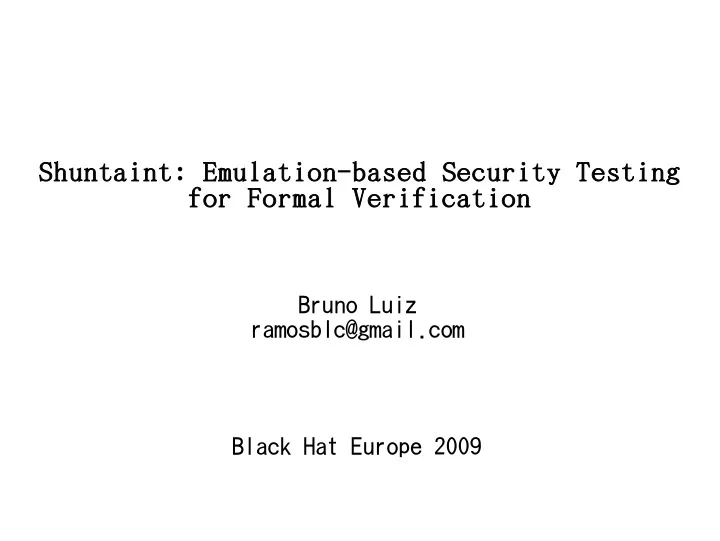

Shuntaint: Emulation-based Security Testing for Formal Verification Bruno Luiz ramosblc@gmail.com Black Hat Europe 2009
Overview Give a brief overview of the emulation- based security testing Introduction to VEX Formalism Implementation details Benchmark programs
What is it? A automated proof in an error or a pattern we are looking for − Detected violation of range or bondary limits − Convergence to an inappropriate point Methods for modeling of symbolic memory − It periodically determines checks for specific user data or functionality can be bypassed Bug-finding during simulated execution of the computer program − Using valgrind “tool plug-in”
Example: bounds checking on static array 8048387 sub $0x18,%esp 804838a sub $0x4,%esp 804838d push $0xf 804838f push $0x0 8048391 lea -0xf(%ebp),%eax 0x7572626a 8048394 push %eax 8048395 call 80482cc <memset@plt> 0x756c6f6e 804839a add $0x10,%esp 804839d sub $0x4,%esp 0x61727a69 80483a0 push $0xf 0x73736f6d 80483a2 pushl 0x8(%ebp) 80483a5 lea -0xf(%ebp),%eax 80483a8 push %eax 0xbf863b00 80483a9 call 80482ec <strncat@plt> 80483ae add $0x10,%esp
Problem Statement Flaws may pass through the software checks Error-checking tool detects something bad happening, but not how error can be triggered Memory-to-Memory propagation cannot address some situations Doesn't perform automatic crafted manipulations trying to replace legitimate memory to trigger bug
Emulation-based Method Abusing of self-modifying code − Translation, instrumentation and compilation to machine code Math background − Very useful in computing sets of states − Ensuring correctness of the model that leads to the error Error trace that leads to an error state − More precise understanding of entry points Untainted Tainted
Dealing with VEX:intermediate representation Library for instrumentation or translation Converts blocks of machine code to an intermediate representation Provides usefull operations for low-level memory manager Architecture-neutral intermediate representation
VEX interface overview Instrumentation suports: VgCallbackClosure: − Thread requesting the translation − Guest address: redirected and non-redirected Superblocks represents instructions Guest state layout contains stack pointer and program counter Byte ranges of original code is available Native word of Simulated/Real CPU have easy control
VEX interface, main fuctions VG_(basic_tool_funcs) − This is enough for initialisation VG_(needs_client_requests) − Trapdoor mechanism VG_(needs_syscall_wrapper) − Trackable events before and/or after system calls VG_(needs_malloc_replacement) − Replace behaviour of friends fuctions
VEX interface, some more functions VG_(track_new_mem_startup) − Memory events notified to the appropriate function VG_(track_new_mem_stack) − Track start of stack VG_(track_pre_mem_write) − Called before an event of memory write Plus fuctions, read/writer register events, thread events, client requests, etc.
VEX IR description Super blocks (IRSB) are blocks of simulated instruction Each IRSB contains a list of statements (IRStmt) with side effects − storing a value to memory − assigning to a temporary variable IRStmt may have expressions (IRExpr) without side effects − arithmetic expressions − loads from memory
Guest code addresses ------ IMark(0x8048384, 1) ------ push %ebp 8048384 55 t0 = GET:I32(20) t19 = GET:I32(16) t18 = Sub32(t19,0x4:I32) PUT(16) = t18 STle(t18) = t0 8048385 89 e5 mov %esp,%ebp ------ IMark(0x8048385, 2) ------ PUT(20) = t18 ------ IMark(0x8048387, 3) ------ 83 ec 18 sub $0x18,%esp 8048387 t2 = Sub32(t18,0x18:I32) sub $0x4,%esp ------ IMark(0x804838A, 3) ------ 804838a 83 ec 04 t5 = Sub32(t2,0x4:I32) PUT(32) = 0x6:I32 PUT(36) = t2 PUT(40) = 0x4:I32 PUT(44) = 0x0:I32
How does this approach work? Analyse programs at run-time at the level of intermediate representation − Modeling, Specification and Verification State transition system Temporal Logic Algorithm
Model Checking Converts a design into a formalism: Memory Graph Find a set of states that satisfy a temporal logic formula − Reverse Tainting Analysis
Network Tainting Network is the most likely vector of attack Data from network File descriptions tracking − Trace all inputs from open file description open, socket, connect, accept, socketpair, and close
Locating Potential Manipulation Look at chunks of guest state Parameter error is written − VG_(get_ThreadState) Mark shadow area as valid Characteristics: − To set these events VG_(track_pre_reg_read) and VG_(track_post_reg_write) are called − Access area of guest's shadow state using VG_(set_shadow_state_area)() and VG_(get_shadow_state_area)() − Record definedness at [offset, offset+len)
Manipulation Layout . . . arg 3 arg 2 arg 1 SYS_xxx(arg 1, arg 2, arg 3, ...);
Locating roots (CWE) Argument Injection or Modification (ID: 88) Return of Wrong Status Code (ID: 393) NULL Pointer Dereference (ID: 476)
Scanning invalid operation Hacking pointer check − Checks accesses to generate a set of tainted value Write-what-where conditions − Adding instructions to VEX IR translated back to machine code How to we get their contents/location? − Pointer: for each possible pointer in memory − LOAD, STORE: interact with memory − Syscalls: memory accesses
Meta-data Mark bit for segment ranges Range check possible pointers for extra space − Generate tainted data a[1] a[2] a[n] ... Instrumentation deals with shadow value − Generate instrumentation
Meta-data lookup Data
Locating root (CWE) Unchecked Array Indexing (ID: 129) − ST<end>(<addr>) = <data> − PUT(16) = <data> Incorrect Pointer Scaling (ID: 468) − Add32(GET:I32(16),<con>) Failure to Handle Length Parameter Inconsistency (ID: 130) − <op>(<arg1>, <arg2>) − ST<end>(<addr>) = <data>
Locating root (CWE) Incorrect Calculation of Buffer Size (ID: 131) − t<tmp> = <data> − <op>(<arg1>, <arg2>) Integer Overflow or Wraparound (ID: 190) − <op>(<arg1>, <arg2>) − ST<end>(<addr>) = <data> Off-by-one Error (ID: 193) − ST<end>(<addr>) = <data> − PUT(16) = <data>
Locating root (CWE) Use of sizeof() on a Pointer Type (ID: 467) Assignment of a Fixed Address to a Pointer (ID: 587) Attempt to Access Child of a Non-structure Pointer (ID: 588)
Future improvements Efficient search procedure Use logical formalism
Thank you! Questions? ramosblc@gmail.com
Recommend
More recommend